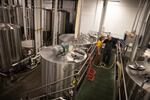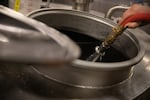
Brewers Zane Tarabochia-Martin and Jordan Davis start a batch of Worthy Brewing's Northwest IPA on Sept. 20, 2022, in Bend, Ore.
Bradley W. Parks / OPB
The brew deck at Worthy Brewing was already pulsing with activity at 6 a.m. on a Tuesday in September. Brewers Jordan Davis and Zane Tarabochia-Martin were starting a new batch of Worthy’s piney and tropical Northwest IPA.
A long tube pumped a steady stream of grain clipping and clapping into a tank known as a mash tun to steep in hot water. Davis rested his hand gently on a dial behind him, every now and again making delicate adjustments to the mixture’s temperature.
“If you mess this part up, the whole day can be pretty rough,” Davis said.

Foam bubbles up between the cracks as grain steeps in hot water in the mash tun at Worthy Brewing in Bend, Ore., Sept. 20, 2022.
Bradley W. Parks / OPB
And a good batch of beer is a terrible thing to waste, especially considering how much water it takes to make one.
Central Oregon’s beer scene has grown up while the region’s water woes have intensified. As local water managers seek to balance the growing demand for a shrinking resource, the brewing industry has come under the microscope.
Related: Bend's beer boom puts a squeeze on water infrastructure
Across the West, breweries are taking measures to reduce their water use. Brewers in Oregon, Colorado and California have experimented with making beer from recycled wastewater. Deschutes Brewery, a behemoth nationally and in Bend, treats its own wastewater in-house.
Worthy is one of several breweries in the region trying to cut back on water use while maintaining a foothold in the competitive craft beer market.
“As a society, [we’ve] been more aware of what a fleeting resource water is in the West,” said Dustin Kellner, Worthy’s director of brewery operations. “As a company, we’ve also been aware of the ways that we can try to mitigate our water loss and keep as much of the water that we use in the product rather than going down the drain.”

Worthy Brewing head of brewery operations Dustin Kellner stands for a portrait among cans soon to be filled with the brewery's Lights Out Stout in Bend, Ore., Sept. 20, 2022.
Bradley W. Parks / OPB
Brewing is a notoriously thirsty business. It requires water for cleaning and sanitizing equipment, mashing grain, rinsing sugars out of the grain and more.
The most efficient breweries use about three gallons of water for every gallon of beer they make. Average breweries are somewhere around 5-to-1 water-to-beer, while some can creep as high as 10-to-1.
Kellner, who got his start home-brewing and working at a small pub in Santa Cruz, California, said the amount of water wasted in brewing becomes more apparent at scaled-up operations like Worthy’s.
The brewery has water meters installed at every drain measuring how much waste is heading to the city of Bend for treatment. Kellner said he’s constantly working to find ways the brewery can cut down on wastewater.

Brewer Zane Tarabochia-Martin rinsing the mash tun while brewing a batch of Worthy Brewing's Northwest IPA in Bend, Ore., Sept. 20, 2022.
Bradley W. Parks / OPB
One way it’s done so is by brewing more. Worthy cleans and sanitizes equipment at the beginning and end of each day. In the summer, when demand is higher, the brewery can produce more beer with the same amount of water for brew deck hygiene.
“Trying to lump multiple brews into fewer days is no different than trying to run as many errands as you can when you get into your car,” Kellner said.
But the brewery’s water use isn’t limited to what goes in the kettles and tuns. It’s restaurants, bathrooms and landscaping, too. To that end, Worthy is transforming its Bend campus into a training ground for water efficiency.

Interprative signs teach visitors to the Worthy Brewing campus about topics like water conservation and soil health in Bend, Ore., Sept. 20, 2022.
Bradley W. Parks / OPB
That’s the charge of Rick Martinson, who directs the brewery’s environmental nonprofit, the Worthy Garden Club. He’s a logger turned archaeologist turned environmental scientist turned landscape artist with a specialty in xeriscaping — drought-tolerant landscaping.
Martinson’s current project is an overhaul of the native plant gardens and bioswales that surround the building. He’s also hoping to turn a retired fermentation kettle into a giant rain barrel to wean Worthy off irrigated water.
Interpretive signs around the brewery and attached organic farm preach the benefits of water conservation and regenerative soils right next to sandwich boards highlighting the latest pale ale.
“We can provide more examples here that are open to the public and as educational opportunities to get other people involved in water conservation,” Martinson said. “A lot of people in Central Oregon think we have lots of water … the water is rapidly disappearing.”

Worthy Garden Club executive director Rick Martinson stands in one of the native plant gardens on the brewery campus in Bend, Ore., Sept. 20, 2022.
Bradley W. Parks / OPB
Beer is firmly established in the state and regional identity. Bend’s brew scene attracts big tourist dollars and even full-time residents who want to work in and enjoy the fruits of the industry.
But the brewing industry sits alongside residential water users, agriculture, fish and wildlife, and others feeling the pressure as demands on Central Oregon’s water grow. Kellner said that, although brewing is easier here than in drier states like California or Arizona, Oregon brewers need to do more to make their business sustainable in the long-term.
“I feel like if breweries don’t do more on their own level to try to at least help with these issues,” he said, “we could certainly see a point where the city of Bend or the county of Deschutes says, ‘We can’t support any more breweries.’”
